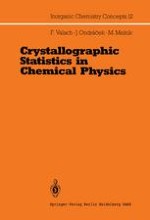1988 | Buch
Crystallographic Statistics in Chemical Physics
An Approach to Statistical Evaluation of Internuclear Distances in Transition Element Compounds
verfasst von: Dr. Fedor Valach, Dr. Jan Ondráček, Dr. Milan Melník
Verlag: Springer Berlin Heidelberg
Buchreihe : Inorganic Chemistry Concepts
Enthalten in: Professional Book Archive
